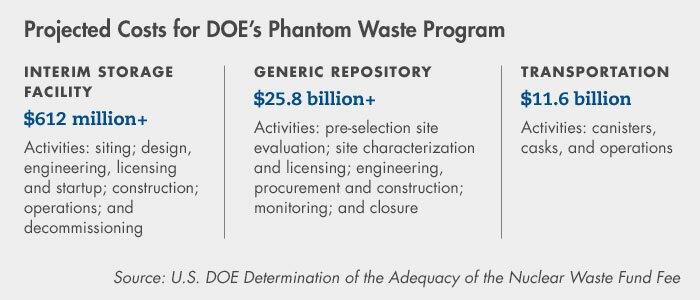Still Waiting for Leadership On ‘Nuclear Waste Issue’
By Ron Witzel, Contributing Reporter
March 05 2013
Whether it’s the U.S. or the U.K., nuclear waste politics are challenging. In two complementary Insight posts, FCW explores how politics and NIMBYism block the execution of technical solutions for managing spent fuel and nuclear waste.
In the first post, Contributing Reporter Ron Witzel questions how, in the absence of any U.S. nuclear waste management program, the Department of Energy’s latest nuclear waste fund adequacy report concluded that “neither insufficient, nor excess revenues are being collected.” In 2009 the Obama Administration killed the Yucca Mountain project, a favor for Senate majority leader Harry Reid, the senior Democratic senator of Nevada, in exchange for Reid’s support for Obama’s 2008 presidential run.
Global Correspondent Roger Murray, meanwhile, writes on the controversial vote by a British county government to reject proceeding to the next phase of the U.K.’s voluntary process for hosting a nuclear waste repository. As has happened more than a few times in the U.S., local political and governmental support for moving forward was thwarted by higher level politics.
On Jan. 16 departing Energy Secretary Steven Chu issued the latest annual Secretarial Determination of the Adequacy of the Nuclear Waste Fund Fee, a surcharge paid by nuclear energy ratepayers (and nuclear utilities) to underwrite the costs of the U.S. nuclear spent fuel disposal program.
Unsurprisingly, as with the 27 fee adequacy reports issued since the Nuclear Waste Policy Act was enacted in 1982, DOE determined in the current iteration that “neither insufficient nor excess revenues are being collected.”
In fact the Energy Department concluded there is no “compelling evidence” that the 1 mil/KwH charged fee should be changed, thereby allowing an additional $750 million per year to be deposited into the Nuclear Waste Fund (NWF).
It is hard to believe that the absence of an actual spent fuel disposal program isn’t “compelling evidence.” Certainly, neither U.S. state regulators nor utilities agree with the assessment.
That’s why NARUC (the National Association of Regulatory Utility Commissioners) and the Nuclear Energy Institute went to court in 2010, when DOE suspended the fee adequacy reports after the Obama Administration killed the Yucca Mountain project.
The case was dismissed after the Energy Department submitted a review with the determination that the fees remained necessary, leading NARUC and NEI to challenge that review in 2011.
Last June, the U.S. Court of Appeals agreed with regulators and industry, and told the federal government to perform an extensive assessment of the necessity for continued collection of the fee. In response the DOE general counsel’s office directed preparation of the fee adequacy report, based on DOE’s Jan. 11 spent fuel strategy document (FCW #504, Jan. 17).
At the end of January, NARUC and NEI asked the federal appeals court to reopen its review of their lawsuit on the waste fee, precisely because DOE’s fee adequacy report still failed to justify continued collection.
Fee for Non-Existent Program
The new 180-page Secretarial Determination Report is a most intriguing document. It describes, with an unprecedented numerical precision and accuracy, future costs for a spent fuel disposal program that is
1. currently non-existent
2. unprecedented in scope
3. has not been authorized by Congress
4. has not been funded
5. does not have a site
6. is based on a never-before-utilized “consensus-based” approval for said site.
The program is based on DOE’s Spent Fuel Strategy, released in mid-January, which calls for authorizing legislation to be passed by Congress in 2014, a pilot storage facility to open in 2021 and a full-scale storage facility to open in 2025, followed by a permanent repository opening in 2048.
To support the continued charging of the 1 mil/KwH fee, the report evaluated 42 scenarios based on three cost estimates (base case, high, and low), two defense share percentages (0% and 20%), and seven economic forecasts (3 x 2 x 7 = 42).
Approximately 38% of the scenarios resulted in a negative ending balance for the NWF and 62% result in a positive balance in the Fund. But as NARUC and NEI point out in their filing, none of the scenarios assess whether the NWF would be adequate to maintain the program, if no new revenues are added.
“DOE’s 42 scenarios have a range of $7 trillion, from the Nuclear Waste Fund having $4.9 trillion more than is needed, to having $2 trillion too little,” the two groups stated in late January.
While the listing of costs is impressive in its breadth and attempted precision, the legal position taken by NARUC and NEI is quite understandable: without the Yucca Mountain project or an alternative project underway, why collect nuclear waste fees for a non-existent program?
On the other hand, there will be costs associated with the future storage of spent fuel, and current electricity users should logically pay for such costs.

Legislation Needed Now
Obviously, leadership is needed in Washington to move Congress to work on legislation to jump-start a U.S. nuclear waste management program, establish the “consent-based” siting of facilities and designate program responsibility to a new government entity specifically responsible for spent fuel.
In so doing, lawmakers would supply the justification the federal government needs to keep taking nuclear waste fees from ratepayers.
With the Feb. 4 unveiling of an energy legislation agenda Sen. Lisa Murkowski (R-Alaska) made a tentative start in the right direction. Her “Energy 20/20” is a 115-page manifesto which can only be described as an aggressive, all-of-the-above strategy.
It covers everything from achieving independence from OPEC by 2020, expanding coal utilization, exploring joint development of Mexico’s oil and gas resources, and promoting marine hydrokinetic power.
And on page 48 there is a one line proposal which states that the government needs to “authorize a quasi-federal entity to manage the back end of the fuel cycle.”
Whether this proposal will ever be turned into actual legislation that is deliberated by Congress and enacted by 2014 as proposed in DOE’s Spent Fuel Strategy is highly doubtful.
Unfortunately, the future of nuclear power in the U.S. depends upon Congress and the White House working together to create a viable disposal project with predictable annual funding levels that nuclear generators and their customers have paid for these last 30 years. The outlook does not appear bright.
Last week the Sacramento Municipal Utility District joined the growing list of utilities which have successfully sued DOE for not performing its legal obligations related to commercial spent fuel. But SMUD won’t soon see the $34.5 million the court awarded, nor will utilities see progress, until new legislation is forthcoming.

Comments